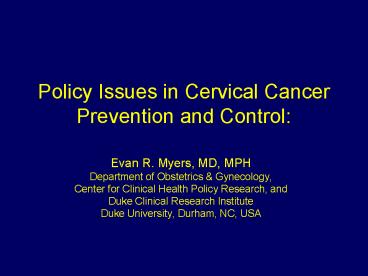Policy Issues in Cervical Cancer Prevention and Control: - PowerPoint PPT Presentation
1 / 23
Title:
Policy Issues in Cervical Cancer Prevention and Control:
Description:
... sensitivity with liquid cytology variable depending on study ... cytology ... Viable alternative to cytology alone, BUT. ONLY if done no more frequently ... – PowerPoint PPT presentation
Number of Views:63
Avg rating:3.0/5.0
Title: Policy Issues in Cervical Cancer Prevention and Control:
1
Policy Issues in Cervical Cancer Prevention and
Control
- Evan R. Myers, MD, MPH
- Department of Obstetrics Gynecology,
- Center for Clinical Health Policy Research, and
- Duke Clinical Research Institute
- Duke University, Durham, NC, USA
2
Disclosure
- Past and present funding
- US Government
- Centers for Disease Control
- Agency for Healthcare Research and Quality
- National Cancer Institute
- Industry
- Digene
- Merck
- Other
- Excellus (HMO)
3
Types of Economic Analysis
- Cost-minimization
- Assumes all outcomes are equal
- Cost-effectiveness
- Compares net costs and net health outcomes
- Examples of outcomes
- Cancer cases, cancer deaths, life expectancy,
quality adjusted life expectancy - If common metric used, allows comparison between
different health needs - Compare cancer prevention to prenatal care
- Cost-benefit
- Outcomes explicitly given financial value
- Difficult to do in practice
- Allows comparison of health care to defense,
education, etc.
4
Cervical Cancer Prevention/Control
- Cost-minimization?
- No good data that there are any prevention or
treatment strategies that are totally equivalent
in terms of outcomes - Radical hysterectomy vs radiation survival
equivalent, but short- and long-term morbidity
different - Cost-benefit?
- No consensus on appropriate method for assigning
fiscal value to outcomes - Cost-effectiveness
- Majority of health economic analyses for cervical
cancer
5
Comparing Policies
- Incremental cost-effectiveness ratio (ICER)
- Policy Net Costs Net Life Expectancy
- A 1000 65 years
- B 2500 70 years
- C 2750 70.5 years
- Comparing B to A ICER (2500-1000)/(70-65)
300/year of life - Comparing C to B ICER (2750-2500)/70.5-70)
500/year of life - Optimal strategy greatest life expectancy with
ICER below some threshold of cost-effectiveness
- US 50-75,000/year of life saved
- Based on dialysis in patients with chronic renal
failure - Consistent even with more recent analyses
6
EFFECTIVENESS
7
Cost-effectiveness in Cervical Cancer
- Focus on mortality reduction
- Usually estimate mean costs, mean life expectancy
of different strategies - Results expressed as cost per year of life saved
- Data to estimate impact of different strategies
limited - No large-scale randomized trials of different
screening strategies - Most available studies of different screening
tests, different treatment for CIN have
methodological weaknesses - Most analyses dependent on modeling
8
(No Transcript)
9
(No Transcript)
10
Quality of Evidence Screening Efficacy
- No published randomized trials of different
screening tests or strategies in terms of
incidence of cancer (difficult logistically and
ethically) - Effect of different screening intervals based on
retrospective study designs, models - Most studies of different screening tests subject
to numerous biases, particularly referral bias
(only positive screening tests undergo reference
standard)
11
Quality of Evidence Screening Efficacy
- In general, in best designed studies
- HPV testing most sensitive
- Conventional cytology least sensitive (51 for ?
CIN1 if ?? ASCUS - Gains in sensitivity with liquid cytology
variable depending on study design - But probably more forgiving of poor technique in
obtaining specimen, leading to overall net
improvement - Consistently, increasing sensitivity associated
with decreasing specificity
12
Quality of Evidence Outcomes
- Good data on efficacy of cancer treatments in
terms of survival - Limited data on comparative efficacy of different
methods of treatment of preinvasive disease - Limited data on effect of preinvasive disease on
pregnancy outcomes - Very limited data on effect of screening,
diagnosis, treatment on quality of life
13
Cost-effectiveness Results
- Ages for screening
- Most efficient time to begin screening mid-30s
- Less detection of transient lesions not destined
to become cancer - Cancers in younger women not as preventable with
screening - Peak incidence of high-grade CIN 30s-40s,
cancer 40s-50s - In screened population, little gain in life
expectancy in continuing screening after 65-70
14
POLICY OTHER CONSIDERATIONS
15
POLICY OTHER CONSIDERATIONS
Cervix Cancer, No Prior Screening
16
POLICY OTHER CONSIDERATIONS
Cervix Cancer, No Prior Screening
Cervix Cancer, 3 Normal Paps
17
POLICY OTHER CONSIDERATIONS
Cervix Cancer, No Prior Screening
Breast Cancer, Men
Cervix Cancer, 3 Normal Paps
18
Cost-effectiveness Results
- Frequency of screening
- As frequency of screening increases, costs
increase much more rapidly than gains in life
expectancy, resulting in rapidly increasing
incremental cost-effectiveness ratios - More frequent screening more likely to detect
transient lesions - Given fixed test sensitivity/specificity, more
frequent tests lead to more false positives
19
Cost-effectiveness Results
- Interaction between screening test sensitivity,
test specificity, and screening frequency - If no change in screening interval
- Increased sensitivity leads to increased costs
- Greater detection of transient lesions
- Decreased specificity leads to increased costs
- Most women normal high absolute number of false
positive tests - More sensitive tests can be more effective and
less expensive then less expensive tests if done
at less frequent intervals
20
Effect of increasing Pap sensitivity at no
marginal cost on overall cost-effectiveness
21
Effect of decreasing Pap specificity at no
marginal cost on overall cost-effectiveness
22
HPV Testing Issues
- Triage of ASCUS
- Equivalent to repeat cytology
- If liquid cytology used, may be less costly
(reduces number of visits)
23
HPV Testing Issues
- Primary screening
- If performed prior to age 30-35
- Very high number of women with positive HPV test,
few with significant lesions - VERY expensive with little benefit
- In women over 30-35
- Viable alternative to cytology alone, BUT
- ONLY if done no more frequently than every 3
years - Otherwise, very expensive, high number of false
positives - Benefits decline as women get older, longer
history of negative Paps































